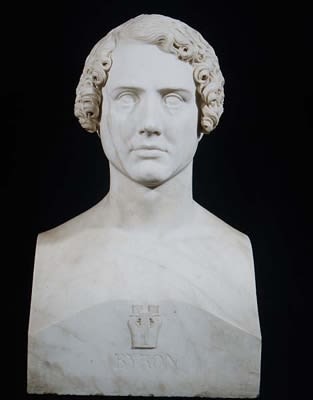
Circle of Bertel (Albert) Thorvaldsen
To view all current artworks for sale visit philipmould.com
Byron is recorded as only having sat once during his lifetime for a sculptor and if we are to believe his protestations, only then under duress. He wrote in 1821,
I would not pay the price for a Thorvaldson bust of any human head except Napoleon's or my children's, or some absurd womankind's ...A picture is a different matter - everybody sits for a picture: but a bust looks like putting up pretensions to permanency, and smacks of a hankering for public fame rather than private remembrance.
The original commission for a portrait bust was requested by Byron's friend John Cam Hobhouse from the Danish sculptor Bertel Thorvaldsen, who from, 1797 had been resident in Italy. The sittings took place in Rome between April 29 and May 20, 1817. From these sitting Thorvaldsen produced a bozetto, which was then used as a model for replicas.
Byron wrote to John Murray in June 1817, Torwaltzen (sic) has done a bust of me at Rome for Mr. Hobhouse, which is reckoned very good. He is the best after Canova, and by some preferred to him. Hobhouse himself wrote of it to Murray a few months later, I shall conclude by telling you about Lord B's bust. It is a masterpiece by Thorwaldsen, who is thought by most judges to surpass Canova in this branch of sculpture. The likeness is perfect; the artist worked con amore, and told me it was the finest head he ever had under his hand.
The original model with a large section of chest, shoulders included, with classical drapery and on a circular pedestal is at the Thorvaldsen Museum in Copenhagen. Nine marble replicas are listed in the catalogue raissone of Thorvaldsen's portrait bust, of which four are in the form of a small full-length herm.
Our bust bears an overall likeness with the known and documented versions of Thorvaldsen's bust but it differs in the style of the hair, which in the prime model is parted in the middle and shorter on the sides. Also, the lyre which is carved on the front of the dado of the bust, is not recorded on any other version. It does appear however, to closely based on the sculptor's bozetto, which was taken from the life-sittings and therefore was probably executed by an assistant working in the master's studio or by someone in the sculptor's circle. Thorvaldsen had a reputation for being erratic in the completion of orders, sometimes delaying them for years and at other times not delivering them at all. Much of the work of completing these commissions would have delegated to pupils in his studio.
It is also documented that some clients demanded minor changes from the prototype bust in order to ensure that their work was an original piece. Byron's hairstyle was probably altered in order to account for a change in fashion, and also to make the sitter look less like a Roman emperor and more like a romantic poet.
William A. Shaw, The Authentic Portraits of Byron, The Connoisseur, Vol. XXX, 1911, p. 253.
Provenance
Collection of John Granville Morrison, Lord Margadale of Islay (b. 1906) at Fonthill House, Tisbury, Wilts;Fonthill House sale, Christie's, 1 November 1971, Lot.58, bt.C.Humphris, 630 gns.;
With Cyril Humphris, Old Bond Street, London and subsequently Shepherd Gallery, New York
Exhibitions
Shepherd Gallery, New York, Winter 1979/80, cat. no.48.Be the first to hear about our available artworks
* denotes required fields
We will process the personal data you have supplied in accordance with our privacy policy (available on request). You can unsubscribe or change your preferences at any time by clicking the link in our emails.